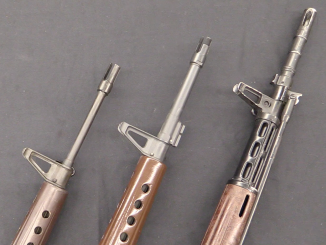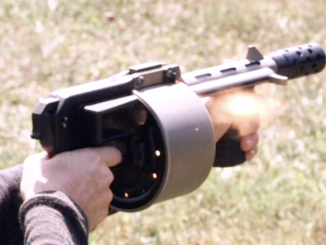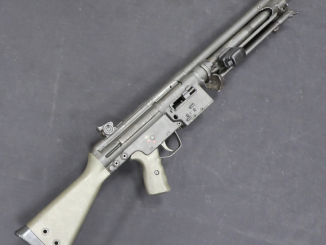In South African military service, the R1 was the FN FAL and was the preferred infantry combat rifle until the adoption of the Galil as the R4 rifle. So what were the guns in between? Well, the R2 was a South African adaptation of the G3. A large number of rifles were needed as a reserve, and also to equip second echelon units like the Air Force, Cape Corps, and South West Africa Territorial Force. To reduce the expense of this, South Africa purchased something like 100,000 G3 rifles from Portugal and designated them R2.
The Portuguese hand guards and buttstocks were found to be unsatisfactory, however. In the heat and harsh ultraviolet radiation of South West Africa (now Namibia) in particular, the plastic would shrink and lose its fit, leading to the guns being called “rattlers” by the SADF troops. The fix this, the American firm of Choate Machine & Tool was contracted to make new hand guards based on the H&K export pattern – wider and longer and with fittings for a bipod. New stocks were also made, duplicating the shape of the R1/FAL stock.




In the Bundeswehr all the G3 handguards had shrunk and were rattling just like these portuguese ones. No wonder, because FMP manufactured an exact licensed copy of the G3. Including the plastic.
That Choate handguard looks like the later pattern handguard that e.g. is found on the G3A7 just with additional holes for ventilation. Does Choate still make those? I might have a need for my rifle. 🙂
The FAL-ish buttstock looks even longer than the original G3 one, making the gun even more awkward. I am actually saving for a Spuhr stock.
The reason they are longer is because south African soldiers are quite large people so the buttstock had to be made longer, same case with the r4 rifle, if you compare the galil and the r4 you’ll notice that the r4’s stock is longer than the galil’s.
This is interesting. I wonder whether Greek and Turkish-made G3 rifles also suffered from the same problem.
The greek ones I have seen yes, because they are pretty much identical to the A3 model. The turkish G3A7 model has a different handguard made from a different plastic. vbut I have no idea how that holds up under heat.
The heat of the barrel alone makes the handguards shrink over time I think. And then you rattle through the forest. As further down Peter Conway-Cleaves notes, many Bundeswehr soldiers also stuffed cleaning wicks or patches in there to stop the handguards from rattling with the predictable result of them smoldering, when firing. The wood furniture is more beautiful anyways. ,-)
Thank you for the input regarding Greek G3s. And yes, I agree with you regarding wood furniture. I don’t think the Spanish Cetme C had this sort of issues.
A minor note. Those of us in SWATF units (701 Bn.) who were deployed 365 days a year, had a firefight an average of every three weeks, and suffered 10% casualties in a year, did not consider ourselves “second line units”.
Wafa Wafa, Wasara Wasara.
Carried both types while a Marine in SA in early’80. Actually shot better with the G3 compared to the R1 and R4. The old style front handguard got very hot when firing full auto. Troopies took to packing the inside with 2X4 cleaning patches which sometimes started to smoulder. Otherwise shield the hand by using the boshoed (soft bush hat) that was normal wear in the bush. SA troops tended to look down on the G3 and would sometimes willfully break the old style stock, while exercising, to hopefully get a R1 (FAL).
The R2 was not a copy of the G3. The R2 was the paratrooper folding stock R1/FN
http://sadf.info/ArmourmentsArmySmallArms.html
Sorry Trevor Morrison, your source is incorrect and this is a common mistake. The R1 was the standard issue rifle. The folding stock version used by the Parabats was manufactured by FN with specific modifications for SA and was officially designated “Paratroop R1 Rifle”. The R2 refers to Portuguese manufactured (FMP) G3A3 rifle. The R3 was a semi-auto R1 originally issued to the Prisons Dept and later issued to the Commandos (part-time rural defence units of the SADF). The R4 was the SA version of the Israeli Galil. As an aside, the folding stock FN shown on the site you mentioned, incorrectly shows the flip type rear sight (probably a picture of a South African Police issue rifle). The R1 Paratroop is unique in that it has the original sliding type rear sight as found on the regular FN/R1, among other unique features only found on the SA R1 Paratroop.
What you forgot to mention is that the R1 and R2/G3 were 7. 62 and the R4 was 5.56. The R4/Galil was made by Israel to replace the Uzi for fighting in urban areas
Correct. In this country there was a big debate about the change from 7,62 to 5.56 calibre. Traditionally, South Africans are/were a nation of hunters/riflemen, used to heavy calibre weapons and hunting at long ranges. The move from .303 Lee Enfield to 7,62 FN/R! was fairly painless, and the musketry of the time emphasized long range aimed fire. The FN/R1 had a reputation (some true, some perception) for long range accuracy and penetration (in the context of the Bush War this was applied in the Rhodesian style “drake shooting” – two aimed shots into the most likely source of cover – often into the base of a tree). And this is where the lighter 5.56 was seen as a disadvantage. The dynamics of Bush War meant long foot and vehicle patrols with minimum action (CONTACT’s), with very occasional semi-conventional attacks. The acceptance by the man-on-the-ground of the benefit of the lighter weight soon outweighed (pun) the benefit of hitting power.
FYI… I’m sure some noticed how the rubber butt pad was beginning to degrade and that’s because they do. I have a furniture set of these on my SAR-3 and they degraded as well.. Although replacement of these will bring the value down, I learned that this butt pads are basically FAL butt pads. I bought some replacing the damaged one with a perfect fit.